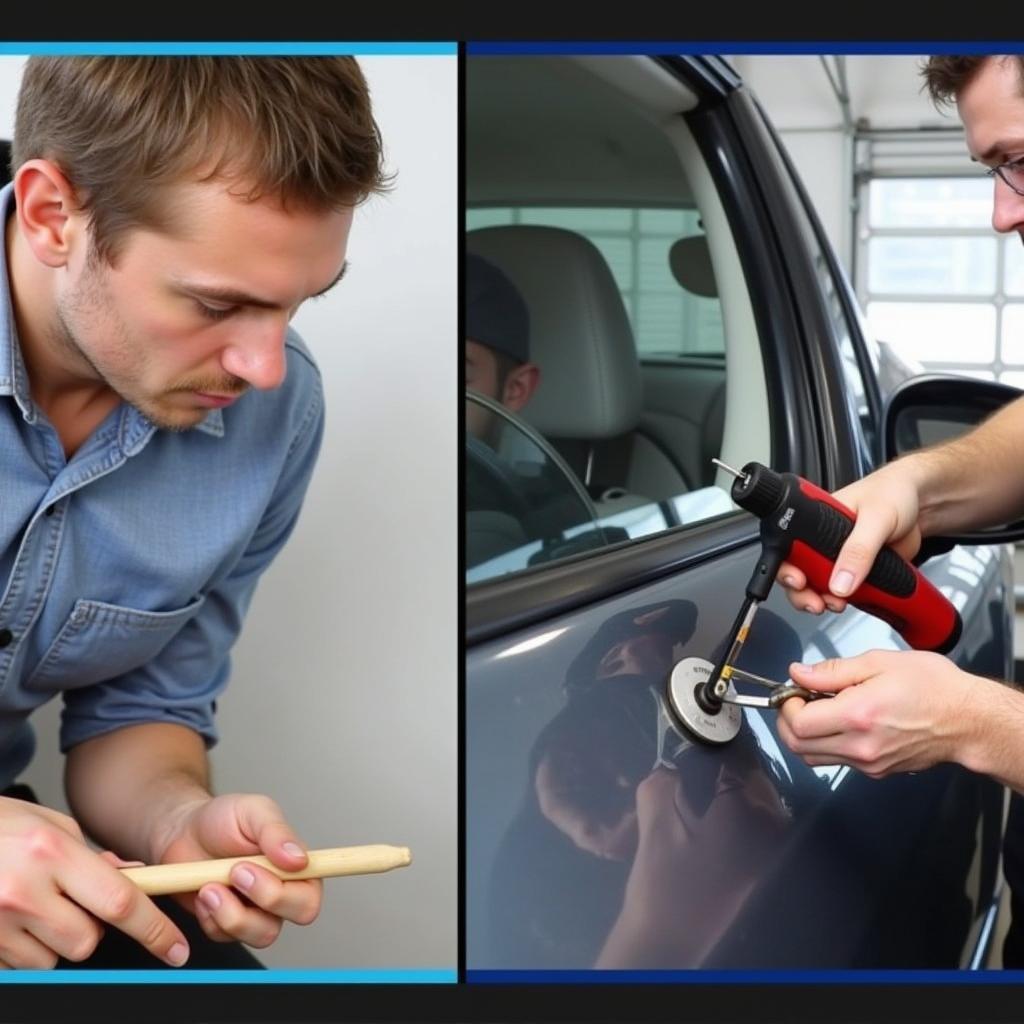Dings and dents are an unfortunate reality of car ownership. Whether it’s a rogue shopping cart, a careless door swing, or hail damage, these imperfections can mar your car’s appearance and even affect its resale value. Fortunately, a variety of Tools For Car Dent Repair exist, offering solutions ranging from simple DIY fixes to professional-grade restorations. This guide will explore the spectrum of tools available, helping you choose the right one for your specific needs.
 Car Dent Repair Tools Overview
Car Dent Repair Tools Overview
Understanding Different Types of Dent Repair Tools
The best tool for car dent repair depends largely on the severity, size, and location of the dent. Minor dents, often referred to as “dings,” can often be addressed with paintless dent repair (PDR) techniques, while larger or more complex dents might require traditional bodywork.
Paintless Dent Repair (PDR) Tools
PDR is a popular method for removing small to medium-sized dents without affecting the original paint job. car paintless dent repair tools are designed to massage the metal back into its original shape from behind the dent. Common PDR tools include:
- Dent Rods: These specialized tools come in various shapes and sizes to access and push out dents from the inside of the panel.
- Glue Pullers: For dents inaccessible from behind, glue pullers offer an effective solution. A glue tab is attached to the dent, and a sliding hammer or pulling device is used to gently pull the dent out.
- Suction Cups: Similar to glue pullers, suction cups create a vacuum to pull out shallow dents.
- Tap Down Tools: These tools are used to gently tap down any high spots or imperfections remaining after the primary dent removal.
Traditional Bodywork Tools for Dent Repair
For more severe dents involving creases, paint damage, or structural deformation, traditional bodywork becomes necessary. car body paintless dent repair tool can sometimes bridge the gap between PDR and traditional methods. However, tools like body hammers and dollies are frequently needed:
- Body Hammers and Dollies: These tools are the backbone of traditional dent repair. The dolly is placed behind the dent to support the metal, while the hammer is used to shape the damaged area.
- Stud Welders: Used to attach pulling pins to severely damaged areas, allowing for controlled pulling and straightening.
- Body Fillers: Used to fill in minor imperfections after the dent has been repaired, creating a smooth surface for painting.
 Traditional Bodywork Tools for Dent Repair
Traditional Bodywork Tools for Dent Repair
Choosing the Right Tools for Car Dent Repair
Selecting the appropriate tools requires careful consideration of the dent’s characteristics. What kind of dent is it? Where is it located? How large is it?
What tools are used for small dents? Small, shallow dents are often ideal candidates for PDR using glue pullers or suction cups.
What tools are used for large dents? Larger dents may require traditional bodywork tools like body hammers and dollies or even stud welders. Sometimes, car body pdr paintless dent repair tools can be employed for larger dents that haven’t damaged the paint.
“Knowing the extent of the damage is crucial,” explains Mike Johnson, an automotive repair expert with over 20 years of experience. “Using the wrong tool can exacerbate the problem and lead to more costly repairs.”
DIY vs. Professional Dent Repair
While some minor dents can be tackled with DIY inspired household car dent repair tools, it’s crucial to understand the limitations. PDR requires skill and practice. Incorrect technique can further damage the panel or create more problems.
“For anything beyond a minor ding, I always recommend consulting a professional,” advises Sarah Chen, a certified PDR technician. “They have the experience and specialized qilu car dent repair tools review knowledge to ensure a flawless repair.”
 DIY vs. Professional Dent Repair
DIY vs. Professional Dent Repair
Conclusion: Finding the Perfect Tools for Car Dent Repair
Finding the right tools for car dent repair involves assessing the damage and understanding the available repair methods. Whether it’s a simple DIY fix or a professional-grade restoration, choosing the correct tool is paramount for achieving a satisfactory result. By considering the information provided in this guide, you’ll be well-equipped to tackle those unsightly dents and restore your car’s pristine appearance.
FAQ
- Can I repair a dented bumper myself? It depends on the material and extent of the damage. Plastic bumpers might require different techniques than metal ones.
- How much does professional dent repair cost? The cost varies based on the size, location, and complexity of the dent.
- Is PDR suitable for all types of dents? No, PDR is typically effective for small to medium-sized dents without paint damage.
- What are the best tools for hail damage repair? PDR tools are commonly used for hail damage repair, but severe cases might require traditional methods.
- Can I remove a dent with a plunger? While sometimes effective for very shallow dents, a plunger is not a reliable dent repair tool.
- How do I prevent future car dents? Park carefully, avoid parking near shopping carts, and consider protective film for vulnerable areas.
7.. What are the signs of poor dent repair? Uneven surfaces, mismatched paint, and recurring dents are signs of a subpar repair.
Common Dent Repair Scenarios
- Scenario 1: Small door ding from a shopping cart: A glue puller or suction cup would likely be the best tool.
- Scenario 2: Large dent with creased metal: This requires traditional bodywork tools like hammers and dollies.
- Scenario 3: Multiple small dents from hail: PDR tools are the preferred method for hail damage repair.
Further Reading and Resources
Check out our articles on car body pdr paintless dent repair tools and inspired household car dent repair tools for more information.
For immediate assistance with your car diagnostic needs, please contact us via WhatsApp: +1(641)206-8880, Email: [email protected] or visit our office at 910 Cedar Lane, Chicago, IL 60605, USA. Our customer support team is available 24/7.

Leave a Reply